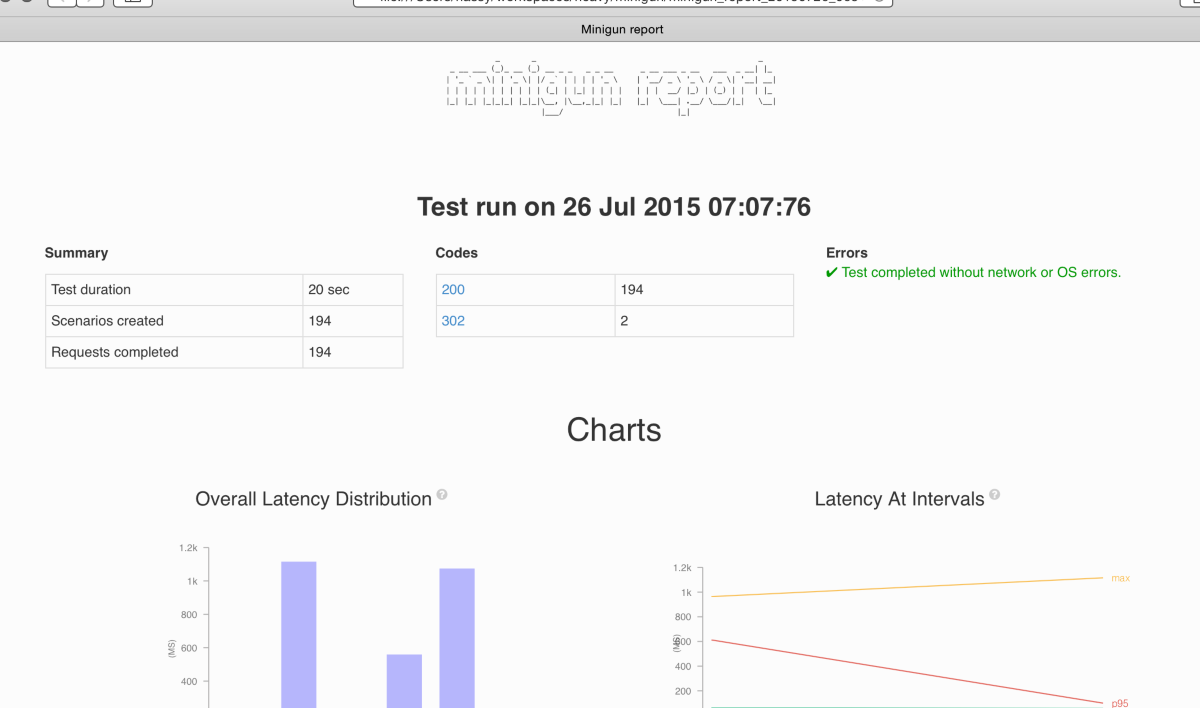
Security News
RubyGems.org Adds New Maintainer Role
RubyGems.org has added a new "maintainer" role that allows for publishing new versions of gems. This new permission type is aimed at improving security for gem owners and the service overall.
_ _
(_) (_)
_ __ ___ _ _ __ _ __ _ _ _ _ __
| '_ ` _ \ | | | '_ \ | | / _` | | | | | | '_ \
| | | | | | | | | | | | | | | (_| | | |_| | | | | |
|_| |_| |_| |_| |_| |_| |_| \__, | \__,_| |_| |_|
__/ |
|___/
minigun is a simple but powerful load-testing tool designed to help you make your apps more performant, reliable, and scalable.
minigun is available via npm
$ npm install -g minigun
$ minigun quick -d 30 -r 5 http://127.0.0.1:3000/test
This will run a test for 30 seconds with an average of 5 new requests to
http://127.0.0.1:3000/test every second.
$ minigun run hello.json
Where hello.json is your tests script that contains something like:
{
"config": {
"target": "http://127.0.0.1:3000",
"phases": [
{ "duration": 120, "arrivalRate": 10 }
],
"defaults": {
"headers": {
"content-type": "application/json",
"x-my-service-auth": "987401838271002188298567"
}
}
},
"scenarios": [
{
"flow": [
{ "get": {"url": "/test"}},
{ "think": 1 },
{ "post": {"url": "/test", "json": { "name": "hassy" }}}
]
}
]
}
Create a graphical report from the JSON stats produced by minigun run with:
minigun report <minigun_report_xxxxx.json>
An example: :tophat:

Minigun is not a web server benchmarking tool. Its sweet spot is performance testing of applications and APIs with complex transactional scenarios.
Having said that, Minigun is capable of generating 500+ RPS on modest hardware
(a 512MB Digital Ocean droplet). Still though, if you are after raw RPS to
simply hammer a single URL, you may want to use wrk instead.
tldr:
Benchmarking an Nginx installation? Use wrk. Testing a Node.js
API, a RoR webapp, or a realtime WebSocket-based app? Use Minigun.
minigun test cases are 100% declarative. Your test-case describes what needs to happen, not how it happens.
Benefits of this approach:
Further reading:
minigun uses the Poisson distribution by default to model how requests are spread over the duration of the test.
What does this mean in practice?
If you specify a duration of 60 seconds, with the arrival rate of 10, it means on average 10 users will arrive every second, with for example 8 arrivals one second and 11 arrivals the next. The inter-arrival period would also be slightly different every time, i.e. 5 users arriving within 1 second (1000 ms) would not be evenly spread out 200ms apart.
This may seem like a subtle difference, but in practice it leads to more robust tests.
Thinking of contributing to Minigun? Awesome! Please have a quick look at the guide.
minigun is 100% open-source software distributed under the terms of the ISC license.
Copyright (c) 2015, Hassy Veldstra <h@veldstra.org>
Permission to use, copy, modify, and/or distribute this software for any
purpose with or without fee is hereby granted, provided that the above
copyright notice and this permission notice appear in all copies.
THE SOFTWARE IS PROVIDED "AS IS" AND THE AUTHOR DISCLAIMS ALL WARRANTIES WITH
REGARD TO THIS SOFTWARE INCLUDING ALL IMPLIED WARRANTIES OF MERCHANTABILITY
AND FITNESS. IN NO EVENT SHALL THE AUTHOR BE LIABLE FOR ANY SPECIAL, DIRECT,
INDIRECT, OR CONSEQUENTIAL DAMAGES OR ANY DAMAGES WHATSOEVER RESULTING FROM
LOSS OF USE, DATA OR PROFITS, WHETHER IN AN ACTION OF CONTRACT, NEGLIGENCE OR
OTHER TORTIOUS ACTION, ARISING OUT OF OR IN CONNECTION WITH THE USE OR
PERFORMANCE OF THIS SOFTWARE.
You made it all the way down here, so here's a dinosaur with a minigun:

FAQs
Load-testing for HTTP and WebSocket-based applications
We found that minigun demonstrated a not healthy version release cadence and project activity because the last version was released a year ago. It has 1 open source maintainer collaborating on the project.
Did you know?

Socket for GitHub automatically highlights issues in each pull request and monitors the health of all your open source dependencies. Discover the contents of your packages and block harmful activity before you install or update your dependencies.

Security News
RubyGems.org has added a new "maintainer" role that allows for publishing new versions of gems. This new permission type is aimed at improving security for gem owners and the service overall.

Security News
Node.js will be enforcing stricter semver-major PR policies a month before major releases to enhance stability and ensure reliable release candidates.

Security News
Research
Socket's threat research team has detected five malicious npm packages targeting Roblox developers, deploying malware to steal credentials and personal data.